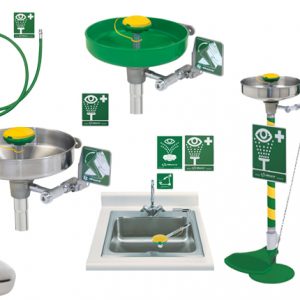Description
hy are emergency showers or eyewash stations important?
The first 10 to 15 seconds after exposure to a hazardous substance, especially a corrosive substance, are critical. Delaying treatment, even for a few seconds, may cause serious injury.
Emergency showers and eyewash stations provide on-the-spot decontamination. They allow workers to flush away hazardous substances that can cause injury.
Accidental chemical exposures can still occur even with good engineering controls and safety precautions. As a result, it is essential to look beyond the use of goggles, face shields, and procedures for using personal protective equipment. Emergency showers and eyewash stations are a necessary backup to minimize the effects of accident exposure to chemicals.
Emergency showers can also be used effectively in extinguishing clothing fires or for flushing contaminants off clothing.
What does the law say?
Consult your local occupational health and safety agency in your jurisdiction and check relevant legislation for any requirements to install this equipment. Currently there is no Canadian standard for the design or placement of eyewash stations or emergency showers. As a result, the American National Standards Institute (ANSI) Standard Z358.1-2014 “Emergency Eyewash and Shower Equipment” is generally used as a guide.
Note: since there is no Canadian standard for emergency showers and eyewash stations, the U.S. ANSI Standard Z358.1-2014 was used in preparing this document.
What is considered to be a ‘flushing fluid’?
The ANSI standard defines “flushing fluid” as any of potable (drinking) water, preserved water, preserved buffered saline solution or other medically acceptable solutions. Local laws may apply in some cases. This document will use the term “water” to mean any of these acceptable flushing fluids unless otherwise specified.
What type of equipment should I install?
Emergency showers are designed to flush the user’s head and body. They should not be used to flush the user’s eyes because the high rate or pressure of water flow could damage the eyes in some instances. Eyewash stations are designed to flush the eye and face area only. There are combination units available that contain both features: a shower and an eyewash.
The need for emergency showers or eyewash stations is based on the properties of the chemicals that workers use and the tasks that they do in the workplace. A job hazard analysis can provide an evaluation of the potential hazards of the job and the work areas. The selection of protection — emergency shower, eyewash or both — should match the hazard.
In some jobs or work areas, the effect of a hazard may be limited to the worker’s face and eyes. Therefore, an eyewash station may be the appropriate device for worker protection. In other situations the worker may risk part or full body contact with a chemical. In these areas, an emergency shower may be more appropriate.
A combination unit has the ability to flush any part of the body or all of the body. It is the most protective device and should be used wherever possible. This unit is also appropriate in work areas where detailed information about the hazards is lacking, or where complex, hazardous operations involve many chemicals with different properties. A combination unit is useful in situations where there are difficulties handling a worker who may not be able to follow directions because of intense pain or shock from an injury.
What specifications should the equipment meet?
Note: All dimensions and measurements are taken from the American National Standards Institute (ANSI) standard Z358.1-2014 “Emergency Eyewash and Shower Equipment”. However, not all dimensions and measurements required by the ANSI standard are listed here.
Emergency Showers
The emergency shower should deliver a pattern of water with a diameter of at least 50.8 cm (20 inches) at 152.4 cm (60 inches). This diameter ensures that the water will come into contact with the entire body – not just the top of the person’s head. ANSI also recommends the shower head be between 208.3 and 243.8 cm (82-96 inches) from the floor. The minimum volume of spray should be 75.7 litres/minute (20 gallons/minute) for a minimum time of 15 minutes.
The shower should also be designed so that it can be activated in less than 1 second, and it remains operational without the operator’s hand on the valve (or lever, handle, etc.). This valve should not be more than 173.3 cm (69 inches) in height. If enclosures are used, ensure that there is an unobstructed area of 86.4 cm (34 inches) in diameter.






Reviews
There are no reviews yet.